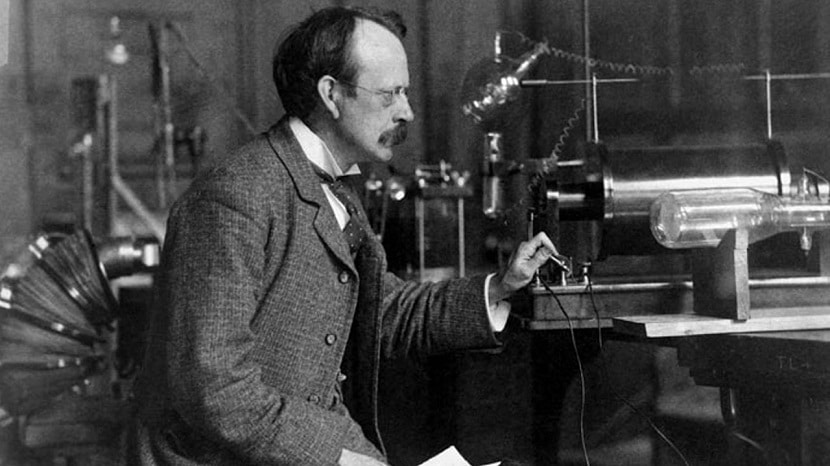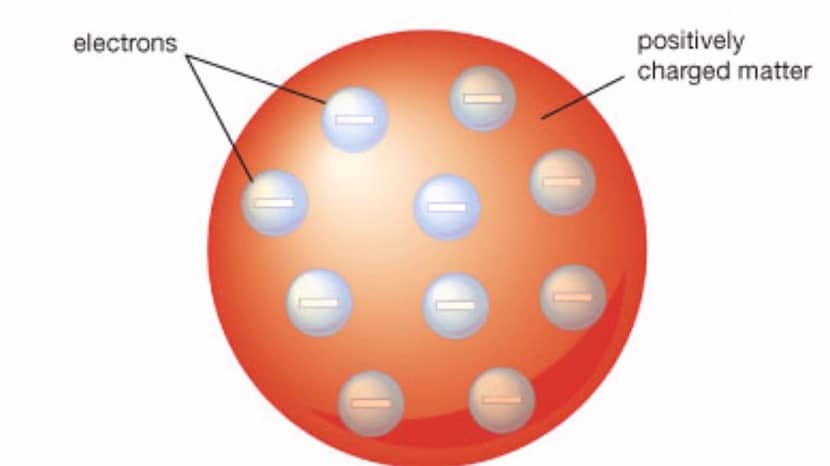
In science there have been many scientists who have made a difference when it comes to knowing how things work. Knowledge about particles, atoms, and electrons has provided many advances in science. Therefore, we are going to dedicate this article to Thomson's atomic model. It was also known as the Raisin Pudding model.
In this article you can learn everything related to Thomson's atomic model, what its characteristics are and how important it was for science.
What is Thomson's atomic model

This is a model that was developed in 1904 and the first subatomic particle may have been discovered. The discoverer was the British scientist Joseph John Thomson. This man was able to discover negatively charged particles through an experiment in which he used cathode ray tubes in 1897.
The consequence of this discovery was quite enormous since there was no evidence that the atom could have a nucleus. This scientist leads us to think that the electrons were immersed in a kind of positively charged substance that counteracts the negative charge of the electrons. This is what made the atoms have the neutral charge.
To explain them in a way that is understood is like placing a jelly with raisins floating inside. Hence the model name pudding with raisins. In this model, Thomson was in charge of calling the electrons corpuscles and considered that they were arranged in a non-random way. Today it is known that they are in a kind of rotating rings and that each ring has a different level of energy. When an electron loses energy it goes to a higher level, that is, it moves away from the nucleus of the atom.
Gold foil experiment

What Thompson thought was that the positive part of the atom always remained indefinitely. This model that he created in 1904 did not have widespread academic acceptance. Five years later Geiger and Marsden were able to perform an experiment with a gold foil that made Thomson's discoveries less effective. In this experiment they passed a beam of helium alpha particles through a gold foil. Alpha particles are nothing more than lions of an element, that is, nuclei that do not have electrons and therefore have a positive charge.
The result of the experiment was that this beam was scattered when it passed through the gold foil. With this, it could be concluded that there had to be a nucleus with a source of positive charge that was responsible for deflecting the light beam. On the other hand, in Thomson's atomic model we had that the positive charge was distributed along what was said as gelatin and which contained the electrons. This means that a beam of ions could pass through the atom of that model.
When the opposite was shown in the subsequent experiment, this model could be denied atomic.
The discovery of the electron also came from a part of another atomic model but from Dalton. In that model, the atom was considered to be totally indivisible. This is what prompted Thomson to think about his Raisin Pudding model.
Characteristics of the Thomson atomic model

Among the main characteristics of this model we summarize the following:
- The atom that this model represents resembles a sphere that has a positively charged material with electrons that are negatively charged. Both electrons and positively charged matter are present inside the sphere.
- The positive and negative charges have the same magnitude. This means that the entire atom has no charge, but is electrically neutral.
- So that the atom in general can have a neutral charge the electrons need to be immersed in a substance that has a positive charge. It is what is mentioned with raisins as part of the electrons and the rest of the gelatin is the part with a positive charge.
- Although it is not explained in an explicit way, it can be deduced that in this model the atomic nucleus did not exist.
When Thomson created this model, he abandoned the previous hypothesis about the nebular atom. This hypothesis was based on the fact that atoms were composed of immaterial vortices. Being an accomplished scientist he wanted to create his own atomic model based on the experimental evidence that was known in his time.
Despite the fact that this model was not entirely accurate, it was able to help in the establishment of fixed bases so that later models could be more successful. Thanks to this model it was possible to carry out different experiments that led to new conclusions and that is how the science that we know today developed more and more.
Limitations and errors of the Thomson atomic model
We are going to analyze what are the issues in which this model did not succeed and why it could not continue. The first thing is that he could not explain how the charges are held on the electrons inside the atom. Not being able to explain this, he also couldn't solve anything about the stability of an atom.
In his theory he did not mention anything about the atom possessing a nucleus. Had today we know that the atom consists of the nucleus composed of protons and neutrons and electrons rotate around at different energy levels.
Protons and neutrons would not yet be discovered. Thompson tried to base his model on an explanation with the elements that had been scientifically proven at that time. When the gold foil experiment was verified, it was quickly discarded. In this experiment it was shown that there must be something inside the atom that would make it have a positive charge and a greater mass. This is already known to be the nucleus of the atom.
I hope that with this information you can learn more about Thomson's atomic model.